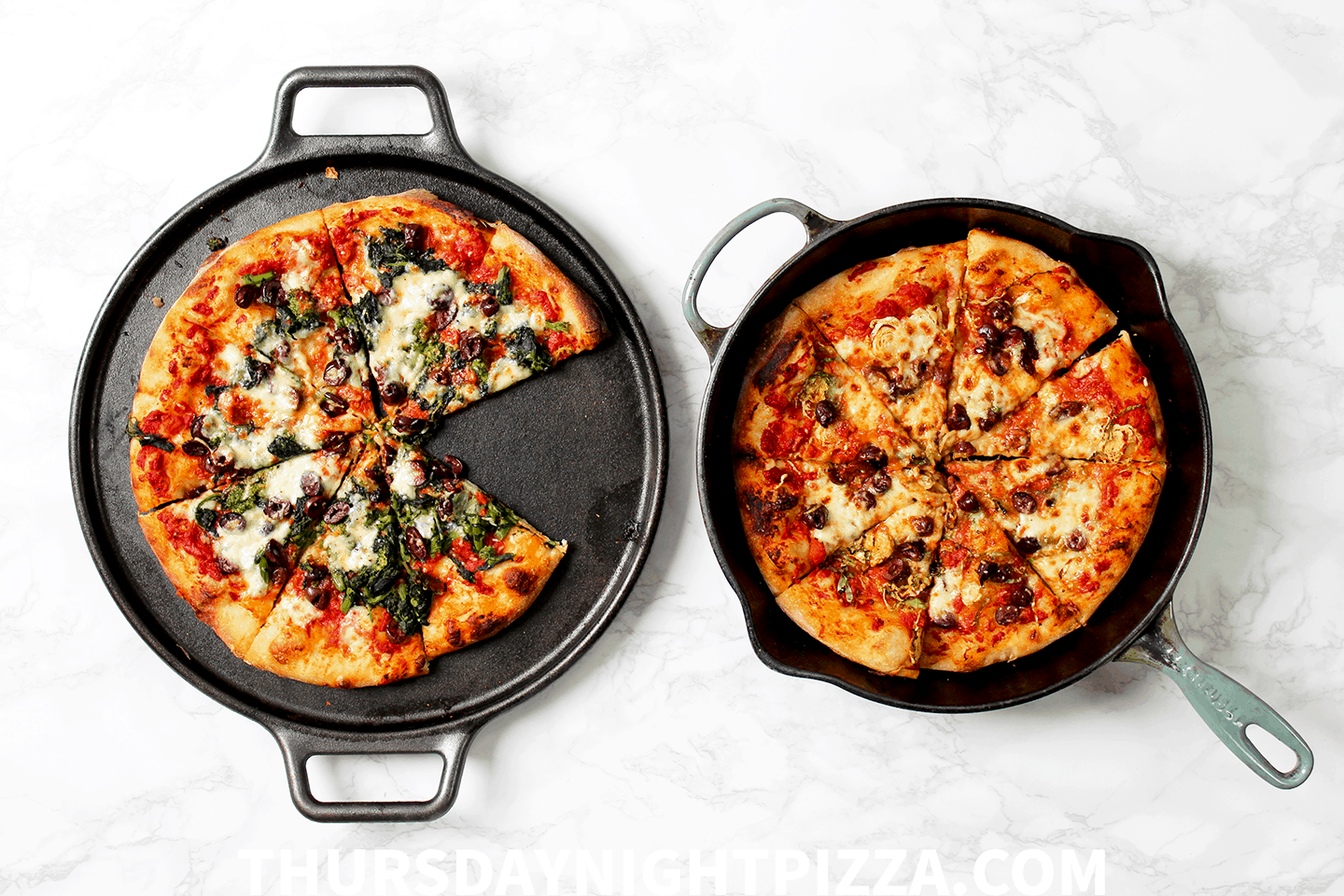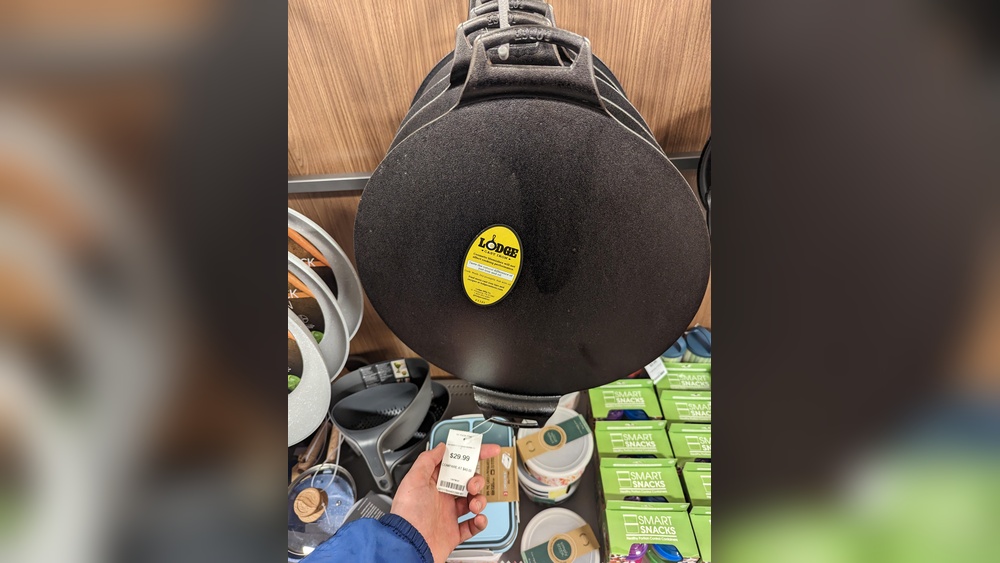Are you torn between a pizza stone and a cast iron pizza pan for making the perfect homemade pizza? Choosing the right tool can change the way your pizza turns out—from crispy crusts to evenly cooked toppings.
But which one suits your style and kitchen best? You’ll discover the key differences, benefits, and drawbacks of each. By the end, you’ll feel confident picking the perfect option to satisfy your pizza cravings every time. Keep reading to unlock the secrets to pizza perfection!
Pizza Stone Benefits
Pizza stones offer many benefits that enhance homemade pizza. They help cook the pizza evenly and create a better crust. Using a pizza stone is simple and can improve your baking results. Many pizza lovers prefer stones because they mimic the effect of a real pizza oven.
Understanding the benefits of a pizza stone can help you decide if it suits your kitchen. It is important to know how a stone works and what makes it special.
Heat Distribution
Pizza stones absorb and hold heat well. This helps spread heat evenly under the pizza. Even heat means the pizza cooks without hot spots. The crust and toppings cook at the same time. This balance prevents burning or undercooking.
Crispy Crust Results
The stone draws moisture from the dough quickly. This makes the crust crisp and firm. A crispy crust is a sign of a well-baked pizza. Stones help create that classic pizzeria texture. Soft or soggy crusts are less likely with a pizza stone.
Durability And Maintenance
Pizza stones are strong and last a long time. They resist cracks and heat damage if cared for properly. Cleaning is simple: just scrape off food and wipe with a damp cloth. Avoid soap and sudden temperature changes. This care keeps the stone working well for years.

Credit: www.reddit.com
Cast Iron Pan Advantages
Cast iron pans offer several benefits that make them popular for cooking pizza. They heat evenly and keep warmth for a long time. This helps cook pizza crusts that are crispy and delicious. Their solid build also means they last for many years.
These pans are not just for pizza. They work well for many types of cooking. Their design helps you cook food evenly on the stove or in the oven. Cleaning and caring for cast iron is simple once you know the steps.
Heat Retention
Cast iron pans hold heat very well. This means the pan stays hot even after you put dough on it. A steady heat helps pizza crust bake evenly and become crispy. The pan’s heavy material spreads heat across the pizza base.
Versatility In Cooking
Cast iron pans can cook many types of food. Use them for frying, roasting, or baking. They work on the stove and in the oven. You can prepare meals like steaks, vegetables, and even bread.
Ease Of Use And Cleaning
Cast iron pans are easy to use with simple care. After cooking, wipe the pan with a cloth or rinse with warm water. Avoid soap to keep the seasoning on the pan. Dry it well to stop rust. Regular use improves the pan’s non-stick surface.
Baking Performance Comparison
Baking pizza with the right tool changes the whole experience. Both pizza stones and cast iron pizza pans offer unique benefits. Understanding their baking performance helps pick the best choice for your kitchen.
Crust Texture Differences
Pizza stones create a crispier crust. They absorb moisture and heat the dough evenly. The result is a crunchy bottom and chewy inside. Cast iron pans give a thicker, softer crust. They hold heat well but trap moisture. This makes the crust more bread-like and less crispy.
Cooking Time Variations
Pizza stones need a longer preheat time. They must reach high heat to cook the pizza properly. Cooking takes about 10 to 15 minutes. Cast iron pans heat up faster. They cook pizza in 8 to 12 minutes. This saves time but may require close watching to avoid burning.
Temperature Control
Pizza stones maintain steady heat during baking. They reduce hot spots in the oven. This helps the pizza cook evenly. Cast iron pans heat quickly but cool faster once removed. They react fast to temperature changes, needing careful oven control. Both need proper oven settings for best results.
Cost And Accessibility
Cost and accessibility play a big role in choosing between a pizza stone and a cast iron pizza pan. Both tools help make delicious pizza, but their prices and availability can differ. Understanding these differences helps you pick the right one for your kitchen and budget.
Price Range
Pizza stones usually cost less than cast iron pizza pans. You can find basic stones for around $20 to $40. High-quality stones may go up to $70 or more. Cast iron pizza pans start at about $30 and can cost over $100. The price depends on the brand, size, and quality of the pan.
Availability
Pizza stones are easy to find in many stores and online. They are common in kitchenware sections. Cast iron pizza pans are also widely available but less common than stones. Specialty shops and online retailers often carry them. Both tools can be shipped to your home, making access simple.
Long-term Investment
Cast iron pans last a lifetime if cared for properly. They get better with use and develop a natural non-stick surface. Pizza stones can crack or break if not handled carefully. Over time, you might need to replace a stone more often than a cast iron pan. Choosing the right tool affects your cooking and budget in the long run.
Maintenance Tips
Keeping your pizza stone or cast iron pizza pan in good shape needs care. Proper maintenance helps these tools last longer and perform better. Simple steps can prevent cracks, rust, and other damage. Follow easy cleaning and storage tips for best results.
Cleaning Techniques
For pizza stones, use a stiff brush or scraper to remove food bits. Avoid soap or detergent; it can soak into the stone. Rinse with warm water only and let it air dry.
Cast iron pans need a different method. Clean them with hot water and a brush. Avoid soaking or using soap often. Dry immediately with a towel. Apply a thin layer of oil to stop rust.
Storage Advice
Store pizza stones in a cool, dry place. Avoid stacking heavy items on top to prevent cracks. Let the stone dry completely before storing.
Cast iron pans should be stored in a dry spot. Keep a paper towel inside to absorb moisture. Stack carefully to protect the seasoning layer.
Preventing Damage
Do not expose pizza stones to sudden temperature changes. Avoid placing a cold stone in a hot oven or vice versa. This can cause cracking.
For cast iron pans, avoid dropping or banging them. Handle with care to keep the surface smooth. Re-season regularly to maintain the non-stick coating and prevent rust.

Credit: www.thursdaynightpizza.com
Choosing The Right Tool
Choosing the right tool for baking pizza can change your cooking experience. Both pizza stones and cast iron pans offer unique benefits. Understanding your needs helps pick the best option. Consider your baking style, kitchen space, and the recipes you enjoy most.
Personal Baking Preferences
Think about the crust texture you prefer. Pizza stones create a crisp, thin crust by absorbing moisture. Cast iron pans offer a thicker, softer crust with a slight crunch. Also, consider how fast you want to bake. Cast iron heats quickly and cooks evenly. Pizza stones need time to heat up but deliver a traditional feel.
Kitchen Space Considerations
Check your kitchen size before choosing. Pizza stones can be large and heavy. They need enough oven space to fit properly. Cast iron pans are usually smaller and easier to store. They can also go from oven to stove, saving space. Choose the tool that fits your kitchen best.
Recipe Compatibility
Think about the types of pizza you like to make. Thin-crust recipes work great on pizza stones. Thick-crust and deep-dish pizzas suit cast iron pans well. Cast iron also works for other dishes, like cornbread or roasted vegetables. Pick the tool that matches your favorite recipes.

Credit: www.lodgecastiron.com
Frequently Asked Questions
What Is The Main Difference Between Pizza Stone And Cast Iron Pan?
A pizza stone provides even heat and a crispy crust by absorbing moisture. A cast iron pan retains high heat, offering a seared, slightly thicker crust with a different texture.
Which Heats Up Faster, Pizza Stone Or Cast Iron Pan?
Cast iron pans heat up faster due to their dense metal. Pizza stones take longer to preheat but distribute heat more evenly for consistent cooking.
Can I Use A Pizza Stone And Cast Iron Pan Interchangeably?
They serve different purposes; pizza stones create crispy crusts, while cast iron pans offer a thicker, pan-style pizza. Use based on your preferred pizza style.
How Do I Clean And Maintain Pizza Stones And Cast Iron Pans?
Pizza stones require no soap; clean with a brush and water. Cast iron pans need seasoning and gentle cleaning to maintain their non-stick surface.
Conclusion
Choosing between a pizza stone and a cast iron pizza pan depends on your needs. Pizza stones give a crispy crust by absorbing moisture. Cast iron pans heat quickly and hold heat well for even cooking. Both tools work well for homemade pizza.
Think about your oven type and cooking style. Each option brings its own benefits to your kitchen. Try both to see which fits your pizza making best. Enjoy making delicious pizzas at home with the right tool.

